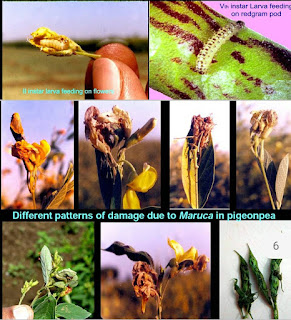Hence, we are importing lot of pigeon pea from abroad. Being an international year of pulses it becomes an important message to all of us that our production and productivity for pigeon pea should increase in a country.
One of the major limiting factors in the production is the damage or the injury caused by insect pest. So managing these insect pests particularly through IPM is the need of the hour. we will try to understand the various pests involved in Red gram and their management. Mainly because of indiscriminate use of insecticides and the excessive use of insecticides which has led to the development of resistance of the insects to the various insecticides is the major cause because of excessive use of the insecticides.
ones again the natural fauna in the red gram ecosystem is being totally reduced then some of the minor pest are the secondary pest is becoming major pest for the IPM implementation. And then due to environmental pollution because over use of pesticide is one of the reason for IPM development.
Lastly, and from the farmer point of view the cost of the input has increased tremendously. There by the net profit has been reduced that’s why there is a need to go for IPM. We will try to understand what are major economically important insect pest attacking our pigeon pea or red gram.
1. Pigeon pea pod borer:
First and the foremost across the country it is only the single pest pigeon pea pod borer scientifically referred as Helicoverpa armigera which is lactose’s insect causes a very significant damage. Significant damage in a sense an average 30 to 35% economic loss is there. Sometimes severe outbreaks about 95 to 100% total damage has been recorded in some parts of the country.
- Why is this Helicoverpa armigera has become so dangerous?
One needs to know that. Because it is a Poly-phagous pest as on know 183 host plants on which the insects is going to cause damage and this insect particularly the adult can move up to 2kms distance and then the insects has a temporary or a facultative to diapauses to overcome the adverse hot temperature situation during summer month.
Then the insect has got a very high fecundity. Fecundity varying from 400 eggs to 1500 eggs/moth which is laid in about 7- 15 days. Particularly, after the cloudy period there is a heavy outbreak of this Helicoverpa mainly because the egg laying increases not only egg laying egg hatching also increases. So, because of these two conditions we see sudden outbreak of Helicoverpa damage on pigeon pea crop on many parts of the country. And more importantly this insect has been reported to develop resistance to almost
the known organophosphorus compound, carbonate compound and in particular synthetic pyrethroids which were really effective when they were released in the beginning. But because of the development of resistance there are reports that up to 200 fold the insect has developed resistance to these insecticides.
2. Leaf and flower Webber:
Followed it up with Helicoverpa since 4-5 years we have another minor pest becoming a major pest that’s Maruca there are 2-3 species which are simply called as leaf webber flower webber.
They are also cause damage to the pods also.
In this photograph you can clearly see various stages of Larvae feeding on different parts of the plant and here also you can very clearly see starting from the foliage webbing till the pod damage you find all sorts of damages on the pigeon pea crop.
3. Pod fly:
Particularly in North India there is a serious pest Pod fly which is referred as Melanoagromvza obtusa which is a distress insect and to the tune of almost around 60% loss is recorded.
And this particular pest deposit egg directly into the seed and you can see one larvae feeding on the seed completing its entire life cycle and pupating there itself and then the adult emerging out from the pod. So, because of these there is a significant loss. Even in South India also of late, late maturing varieties of red gram is recording upto 30-35% economic damage. Then we have some localized pest particularly, sucking pest in the different species of Pod bugs, here it is Clavigrella here it is Reptortus, they in isolated patches cause an economic loss of 15 to 20%. These are the economically important insect pest attacking red gram or pigeon pea across the country.






0 Comments
Please do not enter any spam link on the comment box